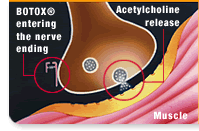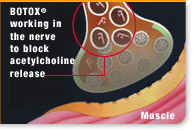![]()
Tampa
(813) 971-3846
![]()
Tampa
(813) 971-3846
BOTOX® is a therapeutic muscle-relaxing agent that works at motor nerve endings (nerves that lead to muscles). It is in a class of drugs called neurotoxins. When considering neurotoxin therapy, it is important to understand how the product works, the history of its use in patients, its protein content, and possible side effects. This page is designed to help you understand more about BOTOX®: what it is, how it works, and how it can help you. Refer to this page in the future should you have further questions about BOTOX® treatment.
BOTOX® is a novel therapeutic agent derived from the bacterium, Clostridium Botulinum. Also known as Botulinum Toxin Type A, the brand BOTOX® is produced in controlled laboratory conditions and given in extremely small therapeutic doses.
Botulinum Toxin Type A is the most studied of the seven different serotypes of botulinum toxin (A, B, C1, D, E, F, G). Each serotype has different properties and actions. No two are exactly alike.

 Normally your brain sends electrical messages to your muscles so that they can contract and move. The electrical message is transmitted to the muscle by a substance called acetylcholine. BOTOX® works to block the r elease of acetylcholine and, as a result, the muscle doesn’t receive the message to contract. This means that the muscle spasms stop or are greatly reduced after using BOTOX®, providing reliable relief from symptoms.
Normally your brain sends electrical messages to your muscles so that they can contract and move. The electrical message is transmitted to the muscle by a substance called acetylcholine. BOTOX® works to block the r elease of acetylcholine and, as a result, the muscle doesn’t receive the message to contract. This means that the muscle spasms stop or are greatly reduced after using BOTOX®, providing reliable relief from symptoms.
BOTOX® is not a cure. For many patients, however, its therapeutic effects have been dramatic – symptoms usually begin to dissipate within three to fourteen days and the effects can last for approximately three months. See Mechanism of Action for more information.
BOTOX® is injected into the muscle. Your doctor will determine the muscle(s) in need of treatment.
A very fine needle is used for the injection. Some patients report minor and temporary discomfort from the injection.
No. Given by a trained physician in the correct amount, there is no danger of botulism from Botox. Botulism is caused by very large amounts of the toxin in the system usually from eating contaminated food. Very high doses, often 100 times more than would normally be used, would have to be injected to cause harm.
The improvement you will achieve from Botox will last anywhere from 3 – 6 months. You will notice a gradual fading of its affect, at which point, you will have to return for re-injection. Some find that it last longer after having multiple treatments and will last months more than it had in the past.
You will notice Botox beginning to work in 2 – 4 days. It will improve over the following 7 – 10 days.
The most common areas are frown lines, forehead lines, and crow feet. Other areas include the neck and upper lip.
The side effects are related to the injection of the solution. This may be a slight discomfort from the needle and a chance of a small bruise. A rare side effect, is a temporary drooping of one eyelid. This is short lived and very uncommon in the hands of experienced doctor.
Botox should not be used on patients who are pregnant, breastfeeding or have a neurologic disease.


Phone: (813) 971-3846
Office Hours:
Mon - Fri: 8am - 5pm
5379 Primrose Lake Cir
Tampa, FL 33647
(Inside the office of The Bowman Institute for Dermatologic Surgery)
Phone: (813) 971-3846
©Copyright 2015 J. Justin Eyelid Institute All Rights Reserved.